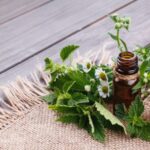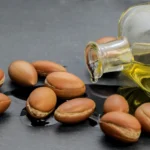Across Africa’s landscapes stand two iconic trees with deep cultural and ecological significance: the baobab (Adansonia digitata), revered as the “tree of life,” and the marula (Cercaria birrea, often subsp. caffra in southern Africa), known for its nourishing fruit and oil. For centuries, communities across Africa have used these trees for food, medicine, rituals, and skincare. Today, baobab oil and marula oil are celebrated globally as natural beauty ingredients.
This article covers their history, skin benefits, sourcing ethics, safety tips, and even a simple DIY recipe to try at home.
Baobab Oil: The Tree of Life in Skincare
Baobabs, which can live for over a thousand years, are ecological and cultural cornerstones in the Sahel and southern Africa. Villagers traditionally gather beneath their wide canopies for markets and meetings, while nearly every part of the tree—leaves, bark, pulp, and seeds—has been used for survival.
Nutrients & Benefits
Cold-pressed baobab seed oil is light, golden, and fast-absorbing. It is especially rich in oleic (omega-9) and linoleic (omega-6) fatty acids, which may help support skin barrier repair and hydration. It also contains vitamins A, D, E, and F alongside antioxidant compounds that may help reduce oxidative stress.
Because of its balanced fatty acid profile, baobab oil sinks in quickly without leaving a heavy residue, making it popular for both dry and combination skin. On hair, it can be used as a light pre-wash treatment to soften strands and soothe dry scalp.Evidence note: Most data on baobab oil’s skincare effects come from ingredient-level studies and traditional use reports; clinical trials remain limited.
Cultural Role
Beyond beauty, baobab pulp has long been eaten as a tart, vitamin-C-rich food in West Africa. Oils and extracts from the tree are sold in local markets, where women often lead small cooperatives that process seeds into oil for domestic and export use.
Marula Oil: Southern Africa’s Beauty Secret
The marula tree is deeply woven into southern African life. Its sweet fruit is eaten fresh or brewed into traditional beverages, and it features in ceremonies celebrating fertility and abundance.
Nutrients & Benefits
High-quality, cold-pressed marula oil is prized for its oleic acid content (making it deeply moisturizing) and its tocopherols (vitamin E) and polyphenols, which provide antioxidant protection. Unlike heavier oils, marula absorbs quickly, leaving skin soft and smooth without greasiness. Its oxidative stability also sets it apart—it resists going rancid faster than many other plant oils, which is why cosmetic formulators value it for serums and creams. Evidence note: Most research comes from compositional analysis and traditional usage; human clinical data on topical benefits remain limited.
Cultural Role
Marula harvests remain community events, with women gathering fallen fruits to process into kernels and oil. In Namibia and South Africa, marula festivals celebrate the tree’s bounty, highlighting its dual role in both nutrition and skincare.
Sustainability & Ethical Harvesting
Both baobab and marula oils illustrate how natural beauty is tied to community and ecology.
- Supply chains: Many oils are produced by women’s cooperatives, supporting rural livelihoods.
- Certifications to look for: Fair Trade, organic, or third-party sustainability audits.
- Greenwashing caution: Marketing terms like “wild-harvested” can be vague. Look for traceable supply stories, Certificates of Analysis (COAs), and evidence of fair community benefit.
- Ecological role: Both trees are critical to biodiversity; sustainable harvesting ensures seeds are collected without damaging ecosystems. Conscious consumer choices help protect these ancient trees and sustain the communities that depend on them.
Practical Usage & Safety
- Facial use: Start with 2–3 drops on damp skin.
- Hair care: Use sparingly as a leave-in for frizz control or apply generously as a 15–30 min pre-wash scalp and hair mask.
- Blending: Combine baobab (lightweight) and marula (silkier) for a balanced day-to-night serum.
- Essential oils: If adding, keep under 0.5% for facial blends. Avoid strong essential oils during pregnancy or if you have sensitive skin.
Storage & Shelf Life
Unrefined oils generally last 6–18 months depending on processing, packaging, and storage. Always check “best by” dates, store in dark glass, and discard if the oil smells rancid or changes color.
Allergy & Sensitivity
Both oils are generally well-tolerated, but natural oils can still cause reactions. Always patch test for 24–48 hours on the inner forearm. Marula oil comes from a tree-nut kernel, so caution is advised for those with nut allergies.
Regulatory note:
These oils are cosmetic ingredients. Claims like “treats eczema” or “cures acne” require regulatory approval; safer phrasing is “may help support hydration” or “helps soften skin.”
DIY Radiance Serum: Baobab & Marula
Ingredients
- 1 tbsp baobab oil
- 1 tbsp marula oil
- 2 drops lavender essential oil (optional, ≤0.5%)
Method
- Mix oils in a dark glass dropper bottle.
- Shake gently.
- Apply 2–3 drops to clean, damp skin at night.
Safety Notes
- Patch test before first use.
- Avoid essential oils if pregnant or sensitive.
- Store in cool, dark conditions; add 1–2 drops vitamin E oil to extend freshness.
Final Thoughts
Baobab and marula oils are more than skincare ingredients they are living legacies of Africa’s ecological and cultural heritage. From baobab markets in West Africa to marula festivals in southern Africa, these oils carry centuries of tradition into today’s beauty routines. By choosing cold-pressed, sustainably sourced oils backed by transparent cooperatives and certification, consumers not only care for their skin but also support biodiversity and rural livelihoods.
Each drop is more than hydration it’s a bridge between ancient practices and modern wellness, reminding us that beauty is strongest when it is rooted in community and sustainability.
Related Posts
-
African beauty oils: Marula & Baobab – Skincare secrets from the continent
For generations, communities across Africa have turned to native trees not only for food and…
-
Finger Millet Pancakes with Baobab Syrup
From the series: Reviving Forgotten Staples — Modern Ways to Enjoy Kenya’s Indigenous Grains A…
-
African beauty oils: Ancestral wisdom meets modern skincare
Across Africa’s diverse landscapes from the sunbaked Kalahari to the lush savannas of West Africa…


